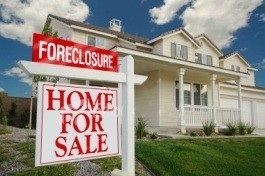 RISMEDIA, April 22, 2009-(MCT)-Lenders for months have been holding back a high volume of homes in the foreclosure pipeline that could further depress home values if they are released at once into the market, industry experts say. The artificially created shortage of foreclosed homes for sale comes when there is a strong resurgence of home buying, with consumers finding, often to their surprise, that they must make multiple offers to compete for a diminished supply of bargain homes. Meanwhile, financial institutions have been encouraged by federal and state lawmakers to slow the foreclosure process to provide more time to work with borrowers on mortgage modifications in an effort to reduce foreclosures.
RISMEDIA, April 22, 2009-(MCT)-Lenders for months have been holding back a high volume of homes in the foreclosure pipeline that could further depress home values if they are released at once into the market, industry experts say. The artificially created shortage of foreclosed homes for sale comes when there is a strong resurgence of home buying, with consumers finding, often to their surprise, that they must make multiple offers to compete for a diminished supply of bargain homes. Meanwhile, financial institutions have been encouraged by federal and state lawmakers to slow the foreclosure process to provide more time to work with borrowers on mortgage modifications in an effort to reduce foreclosures.
Scott Anderson, vice president and senior economist with Wells Fargo, said also by withholding a portion of foreclosed properties from the market, lenders may deliberately be preventing home prices from falling as fast as they otherwise would.
A tally by one company that closely monitors foreclosures showed only about a third of repossessed houses are being actively marketed. If this “phantom supply” of bank-owned houses is put up for sale at once, Anderson said, it would probably prompt another steep plunge in property values.
“The danger is this could be devastating for the banks’ balance sheets and for anyone else trying to sell a house or refinance their mortgage,” he said.
The banks “would be crazy to flood the market and cause prices to sink. Their own assets would be worth more if they brought the foreclosures in slowly,” said John Husing, a Redlands-based economist.
Husing has predicted Inland Southern California home prices will stop falling in the next couple of months because of shrinking inventory and growing buyer demand.
Sean O’Toole, founder and chief executive of ForeclosureRadar, a California information Web site, said mortgage servicers have told him “They want to be careful about putting out too many properties at one time because they believe supply and demand are affecting prices.”
The median price of an Inland house has dropped 43 percent in San Bernardino County and 39 percent in Riverside County in the past year, but the rate has slowed in recent months.
Statistics confirm that banks are keeping foreclosed houses off the market much longer than usual, said Rick Sharga, senior vice president of RealtyTrac, a company that monitors foreclosure trends nationally.
Sharga said RealtyTrac studied the 234,716 bank-owned California homes in its database as of the end of November and discovered that only 34 percent were advertised through the state’s dozens of multiple listing services, which is how bank-owned properties are normally marketed.
“We were frankly stunned by that,” Sharga said. Usually repossessed houses are processed, fixed up and listed for sale within 30 days, he said.
While the gradual release of foreclosed properties helps to prop up prices, it also could prolong the real estate recession, Anderson said.
Other objectives the banks may have, Sharga said, include deferring accounting losses they would have to show once foreclosed properties are sold at depressed prices. Or they may be waiting to see if the federal government will offer them more money for their defaulted mortgages than they could get by selling foreclosed houses on the open market.
Foreclosure Hiatus
Also, the foreclosure process has been interrupted repeatedly by federal and state moratoriums designed to encourage lenders to modify loans to help financially stressed homeowners keep their homes.
Two large government-controlled lenders, Fannie Mae and Freddie Mac, in November imposed holiday suspensions of foreclosure-related evictions that were repeatedly extended until March 31.
At the request of Congress, JP Morgan, Morgan Stanley, Wells Fargo, and Bank of America also agreed to suspend foreclosures of owner-occupied homes until the Obama Administration crafted a mortgage modification strategy. In California, legislation took effect in September that requires lenders to give borrowers 30 days notice before taking the first step toward foreclosure. And starting this summer, loan servicers in the state must delay for 90 days the foreclosure of owner-occupied homes or have a comprehensive loan modification program.
As the moratoriums expire, the number of foreclosures is expected to spike.
Meanwhile a surge of first-time home buyers and investors, attracted by low prices and mortgage rates and government tax incentives, are competing for a diminishing number of homes for sale.
Buyers are snapping up foreclosed houses, many of which receive multiple offers, faster than they can be replaced by new foreclosures.
“Sales are much higher than last year, but we are running out of houses to sell,” said Kim Kershaw, sales manager of the Corona office of Prudential California Realty and an agent who sells real-estate-owned (reo) property.
Buying Season
According to the Multi-Regional Multiple Listing Service on Tuesday, there were about 21,000 homes for sale in its territory, which includes the San Gabriel Valley, South Bay and Riverside and San Bernardino counties, with the exception of Victor Valley and the Coachella Valley.
The listing service said that is about half of the 40,000 active listings it had a year ago and the lowest number since March 2006, when the listing service did not include South Bay.
Of the 5,600 existing homes that sold in the multiple listing service’s region last month, about 3,000 were either bank-owned or sold for less than their mortgages, underscoring the key role of foreclosures in today’s housing market.
“At the rate they are dishing out these repos (repossessed houses) it will be years before they all sell,” said Kershaw, who claims that the banks are missing out on a great opportunity to clear out their foreclosures. “It is spring and we are in the big buying season. This is probably not the time to choke the market with no inventory. It is like not having iPods at Christmastime,” she said.
Copyright © 2009, The Press-Enterprise, Riverside, Calif.
Distributed by McClatchy-Tribune Information Services.










